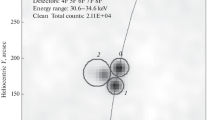Abstract
We have used Yohkoh and GOES X-ray observations to investigate flares with a long rising phase. We have found that a characteristic feature of such flares is a long time interval, Δ t ≥ 20 min, between the temperature maximum and the maximum of the emission measure. We have carried out detailed analysis for 10 limb flares of this type. Time variation of the heating function, E H(t), has been determined for their loop-top X-ray kernels. The time variation of E H(t), together with the temperature–density diagnostic diagrams, have been used to explain the large value of the time interval, Δ t. The main point is that for these flares the heating function E H(t) decreases so slowly after the temperature maximum, that for the long time, Δ t, the energy flux reaching flare foot points is sufficient to maintain significant chromospheric evaporation. Investigation of the flare evolution in the temperature–density diagnostic diagrams allowed us to work out a new method of determination of the density for flare kernels. This method can be applied to all the kernels for which their altitudes can be estimated. The advantage of this method is that for the density determination it is not necessary to assume what is the extension of the emitting plasma along the line of sight.
Similar content being viewed by others
References
Hudson, H. S. and McKenzie, D. E.: 2000, in R. Ramaty and N. Mandzhavidze (eds.), High-Energy Solar Physics: Anticipating HESSI, ASP Conf. Ser. 206, 221.
Jakimiec, J., Sylwester, B., Sylwester, J., et al.: 1986, Adv. Space Res. 6, 237.
Jakimiec, J., Sylwester, B., Sylwester, J., et al.: 1987, in V. E. Stepanov and V. N. Obridko (eds.), Solar Maximum Analysis, VNU Science Press, Utrecht, p. 91.
Jakimiec, J., Sylwester, B., Sylwester, J., et al.: 1992, Astron. Astrophys. 253, 269.
Jakimiec, J., Tomczak, M., Falewicz, R., et al.: 1998, Astron. Astrophys. 334, 1112.
Jakimiec, J., Tomczak, M., Falewicz, R., and Mikurda, K.: 2002a, Adv. Space Res. 30, 677.
Jakimiec, J., Falewicz, R., and Tomczak, M.: 2002b, Adv. Space Res. 30, 659.
Masuda, S.: 1994, PhD thesis, University of Tokyo.
Rosner, R., Tucker, W., and Vaiana, G.: 1978, Astrophys. J. 220, 643.
Author information
Authors and Affiliations
Corresponding author
Rights and permissions
About this article
Cite this article
Bąk-Stęślicka, U., Jakimiec, J. Investigation of X-Ray Flares with Long Rising Phases. Sol Phys 231, 95–115 (2005). https://doi.org/10.1007/s11207-005-8780-2
Received:
Accepted:
Issue Date:
DOI: https://doi.org/10.1007/s11207-005-8780-2



